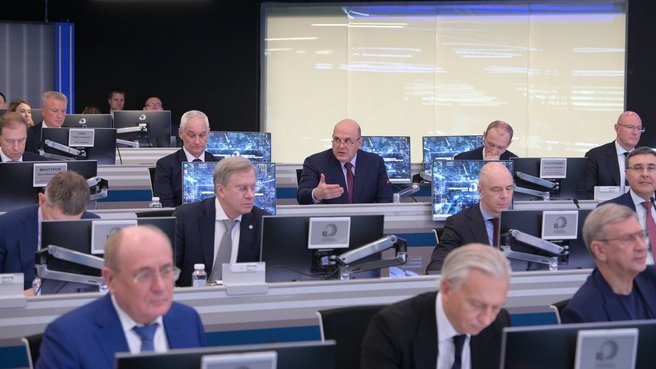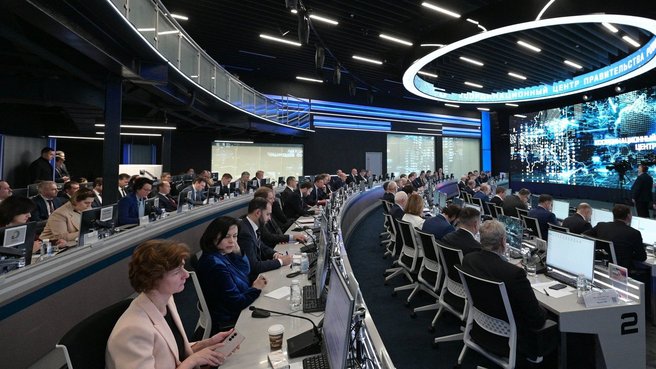Mikhail Mishustin: “According to preliminary data, last year, industrial output increased 3.5 percent with the manufacturing industries accounting for much of this growth with an increase of 7.5 percent. The machine building sector showed the highest growth rate at about 21 percent.”
Mikhail Mishustin during the strategic session on carrying out socioeconomic development initiatives and achieving a technological breakthrough
Mikhail Mishustin’s opening remarks:
Good afternoon, colleagues.
Today, we will continue to discuss progress in carrying out major projects designed to address our priority objectives in terms of improving the quality of life for our people.
We are moving to the next bloc, the biggest one in fact, which includes 15 of the 42 strategic initiatives our President initiated about two years ago. Every track on this list serves as a technological development driver for our country. Importantly, they are all part of system-wide decisions adopted by the President and the Government. They operate in unison with the national projects and state programmes, as will all other comprehensive initiatives aimed at supporting various sectors.
Overall, these efforts have been quite effective. Not only have our manufacturers adapted to operating in a new environment and reshaped their cooperation and logistics chains, but have also been able to expand their manufacturing capabilities and to gradually tap the market segments left vacant after several foreign companies left.
According to preliminary data, last year, industrial output increased 3.5 percent. The manufacturing industries account for much of this growth with an increase of 7.5 percent. The machine building sector showed the highest growth rate at about 21 percent.
The President recently addressed a meeting of the Science and Education Council and noted that science and technological development priorities should be closely related to all key economic, social-sector and security challenges, and that they should aim to attain sovereignty in all fields.
We need to proceed with this approach as we implement the initiatives that include a wide range of projects, including engineering, research and development projects as we initiate innovative systems and high-tech equipment.
Over the past two years, we have allocated about 200 billion roubles’ worth of federal funding for these projects, and there are plans to spend 122 billion more throughout 2024. At the same time, extra-budgetary funding volumes exceed federal allocations by 100 percent, reaching 228 billion last year. This proves that private investors are very interested in these projects.
In addition to strengthening the nation’s industries, these projects create additional incentives for our energy, transport, agriculture, medical and many other sectors whose successful performance directly influences specific aspects of our people’s lives; moreover, they improve the environment and help businesses minimise spending.
We have made considerable headway in developing autonomous cargo transport systems. Today, we are testing these systems on motorways and at sea. For example, KAMAZ has started manufacturing automated lorries. We have started operating them on the high-speed M-11 motorway between Moscow and St Petersburg. In fact, this is elevating logistics between the two largest Russian cities to a new level.
Under the Clean Energy initiative, we have built about 20 “green” power-generating facilities with a total capacity of 340 megawatts, including the Smaller Krasnogorsk Hydropower Plants that were recently activated during our trip to the Karachayevo-Circassian Republic.
These technologies will facilitate more reliable energy distribution to Russia’s regions and will reduce the volume of toxic emissions into the atmosphere. This, of course, improves the environment in various communities.
We are supporting innovative research in hydrogen and atomic energy. This is an area where Russia has great potential like with LNG processing.
We are also working on modern solutions that can help preserve people’s health and boost efficiency in preventing and treating serious diseases like diabetes mellitus and hypertension. A series of high-technology products is being developed to enable remote health monitoring. Patients will soon gain access to this system, which is capable of continuously monitoring vital health indicators.
We also have many inventors, craftspeople and enthusiasts, who suggest many interesting ideas. But these talented people need support in implementing their creative plans. We are also focusing on supporting technological startups at all stages from original concept through inclusion on the stock market as experienced participants.
About 5,000 businesses have taken advantage of these opportunities over the past year, a third of them in a seamless process due to simplified interaction between development institutions.
Nearly 60 businesses received grants totalling 9 billion roubles. This will make it possible to open or expand manufacturing facilities to fill major corporate orders. Another 34 billion roubles has been provided in related preferential loans, with over 200 companies making use of the funds.
We have established a special related digital platform to facilitate the search for investors and industrial partners. It contains information about 10,000 startups and about the same number of promising projects.
We are also promoting educational initiatives by forming an ecosystem of technological entrepreneurships. It covers most regions of the country, hundreds of universities and about half a million students and teachers.
We are fulfilling one more important assignment – the forward-looking training of industrial workers. We have opened advanced engineering schools at 30 universities and plan to increase that number to 50.
Of course, at the same time, we are upgrading educational programmes by introducing new formats of practices and practical training. Our main goal is to promote interest among students in the technical professions at school.
Colleagues,
I would like to suggest that we listen to reports by the directors of our initiatives on socio-economic development. We will discuss in detail key indicators, primarily, their effect on people and industries.
In this context, it is most important to bring every project to completion, to specific practical solutions. We must closely monitor which of the announced targets have been reached and which are still outstanding. We can only do this if we attend to the needs and hopes of people. Therefore, we must always study the feedback on our socio-economic initiatives, government programmes and national projects.









